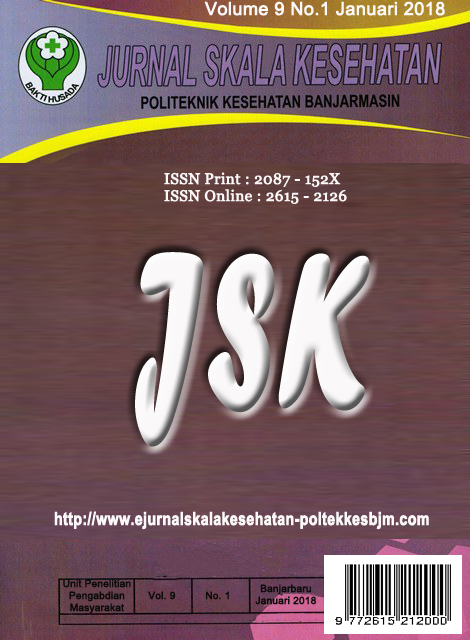Madu lebah kelulut (Trigona Spp.) dalam aktifitas terhadap bakteri Staphylococcus aureus resisten
Abstract
Infection caused by Staphylococcus aureus bacteria becomes a very serious problem because of the increased resistance of these bacteria to various types of antibiotics. Honey has antibacterial activity because it contains water, acidity and inhibitor compounds namely flavonoids. Honey can be produced Trigona spp. This study aims to Minimum Inhibitory Concentration (MIC) and Minimum Bactericidal Concentration (MBC) and effectiveness of honey bee kelulut (Trigona spp.) Against Staphylococcus aureus resistant cephalosporin bacteria in vitro. This research is true experiment with postest only control group design. The results of the study were measured by MIC showed no clarity at concentrations of 60 mg / ml, 70 mg / ml, 80 mg / ml, 90 mg / ml and and clarity at concentrations of 100 mg / ml, and MBC at concentrations of 60 mg / ml of 151 colonies, 70 mg / ml of 105 colonies, 80 mg / ml of 55 colonies, 90 mg / ml of 16 colonies and 100 mg / ml of 0 colonies. The effective concentration in killing Staphylococcus aureus resistant cephalosporin is 100 mg / mlReferences
R. D. Dwiyanti and L. Lutpiatina, “Mutu Bakteriologis Saus Tomat Pentol di Banjarbaru,” Med. Lab. Technol. J., vol. 2, no. 1, pp. 1–5, 2016.
R. D. Dwiyanti, A. Muhlisin, and A. Muntaha, “MRSA dan VRSA Pada Paramedis RSUD Ratu Zalecha Martapura,” Med. Lab. Technol. J., vol. 1, no. 1, pp. 27–33, 2015.
Amalia, R. D. Dwiyanti, and Haitami, “Daya Hambat NaCl Terhadap Pertumbuhan Staphylococcus aureus,” Med. Lab. Technol. J., vol. 2, no. 2, pp. 42–45, 2016.
L. Lutpiatina, “Pewarnaan Gram Buffy Coat Untuk Deteksi Awal Pasien Bakteremia,” Med. Lab. Technol. J., vol. 1, no. 1, pp. 38–46, 2015.
Sun, T., et al. “The imoact of psychological capital on job embeddedness and job performance among nurse : A structural equation approach,” J. Adv. Nurs., vol. 61, 2011.
Haryanto, B., Hasan, Z., Kuswandi & Artika, “Penggunaan Propolis untuk Meningkatkan Produktivitas Ternak Sapi Peranakan Ongole (PO),” JITV, vol. 17, no. 3, p. 202, 2012.
A. Rahmi, E. Roebiakto, and L. Lutpiatina, “Potensi Ekstrak Rimpang Kencur ( Kaempferia galanga L.) Menghambat Pertumbuhan Candida albicans,” Med. Lab. Technol. J., vol. 2, no. 2, pp. 70–76, 2016.
S. Hamad, Terapi Madu: Panduan Praktis untuk 84 Penyakit, Plus untuk Stamina Mental. Depok: Pustaka Ilman, 2007.
S. Sulaiman, Terapi dengan Madu : Dar Al-Faruq Lin Nasyr wat Tauzi. Surakarta, 2010.
Boorn K.L., Khor Y.Y., Sweetman E., Tan F., Heard T.A., “Antimicrobial activity of honey from the stingless bee Trigona carbonaria determined by agar diffusion, agar dilution, broth microdilution and time kill methodology,” J. Appl. Microbiol., no. 108, pp. 1534–1543, 2009.
R. D. Dwiyanti, Nurlailah, and I. K. Widiningsih, “Efektivitas Air Rebusan Daun Binahong (Anredera cordifolia) Terhadap Pertumbuhan Salmonella typhi,” Med. Lab. Technol. J., vol. 1, no. 1, pp. 1–6, 2015.
Hijriah, R., Winarsih, S., “Efek Antibakteri Madu Apel dan Madu Klanceng terhadap Staphylococcus aureus Isolat 034p secar a In Vitro,” J. Penelit. Fak. Kedokt. Univ. Brawijaya Malang, 2014.
Publishing your paper with JURNAL SKALA KESEHATAN POLITEKNIK KESEHATAN BANJARMASIN (JSK) means that the author or authors retain the copyright in the paper. JSK granted an exclusive reuse license by the author(s), but the author(s) are able to put the paper onto a website, distribute it to colleagues, give it to students, use it in your thesis etc, even commercially. The author(s) can reuse the figures and tables and other information contained in their paper published by JSK in future papers or work without having to ask anyone for permission, provided that the figures, tables or other information that is included in the new paper or work properly references the published paper as the source of the figures, tables or other information, and the new paper or work is not direct at private monetary gain or commercial advantage. JSK journal provides immediate open access to its content on the principle that making research freely available to the public supports a greater global exchange of knowledge. This journal is licensed under a Creative Commons Attribution-ShareAlike 4.0 International License. This license lets others remix, transform, and build upon the material for any purpose, even commercially. JSK journal Open Access articles are distributed under this Creative Commons Attribution-ShareAlike 4.0 International License (CC BY-SA). Articles can be read and shared for All purposes under the following conditions:
BY: You must give appropriate credit, provide a link to the license, and indicate if changes were made. You may do so in any reasonable manner, but not in any way that suggests the licensor endorses you or your use.SA: If you remix, transform, or build upon the material, you must distribute your contributions under the same license as the original.






















